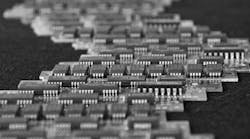China's Tsinghua Unigroup Invests $30 Billion in Memory Chip Fab
After failing to buy influence and insight from American memory chip makers, Tsinghua Unigroup, the national champion for China’s aggressive push into semiconductors, said that it would build a manufacturing plant for its own technology.
The move is the latest and most expensive twist in a government-supported plan to replace over $200 billion in semiconductor imports with Chinese-made chips. China is current limited in its ability to supply memory chips for its vast electronics industry, which is brimming with inexpensive smartphones and other low-end devices.
In an announcement last week, Tsinghua divulged plans to build a $30 billion memory chip factory in Nanjing, China. To start, the company that it would invest $10 billion to construct the factory and produce its first 100,000 chips. The company didn’t mention any production timeline for the plant.
A state-controlled firm, Tsinghua is viewed as the public face of China’s strategy to become a semiconductor superpower. The company spun out of Tsinghua University, whose alumni include current President Xi Jinping and other top government leaders. It also once employed Hu Haifeng, the son of the former president Hu Jintao, as its ambassador to the Chinese Communist Party.
Tsinghua became the country’s largest chip maker after it bought Spreadtrum Communications and RDA Microelectronics, two of China’s largest mobile chip firms, in 2013. Tsinghua’s chairman Zhao Weiguo has pledged to invest $47 billion to become the world’s third largest chipmaker by 2020.
The new factory will dovetail with other memory chip projects connected to Tsinghua. The Chinese chip foundry XMC is using government funding to build a $24 billion memory chip factory in Wuhan. XMC is owned by a holding company, Yangtze River Storage Technology, which itself is controlled by Tsinghua.
Headed by a former executive at Semiconductor Manufacturing International Corporation, XMC has previously worked with Spansion to produce several types of flash memory. Spansion merged with Cypress Semiconductor in 2015.
The Nanjing factory will produce NAND chips, which are vital for everything from storing photographs in smartphones to playing videos on laptops. It will also make 3D NAND chips with layers of memory stacked in three dimensions to improve storage capacity.
Tsinghua also said it would install tools for making dynamic-random access memory, or DRAM, which can access data faster than NAND but loses it when the power is turned off. DRAM is mostly used as main memory in smartphones to set top boxes to servers.
Tsinghua will start construction after several failed attempts to buy American chip insight. In 2015, it placed a $23 billion bid for Micron Technology, who rejected the offer because it was unlikely to be approved on national security grounds. Most analysts warned that such a large deal would be blocked.
For a similar reason, a subsidiary of Tsinghua’s holding company last year pulled out of a $3.78 billion deal to acquire 15% of Western Digital, one of the biggest makers of hard disk drives and now the owner of NAND technology through its acquisition of SanDisk.
The panel that reviews such deals is known as the the Committee on Foreign Investment in the United States, or Cfius. Over the last two years, it has increasingly blocked of Chinese technology deals and protective of advanced chips that can be used in defense systems and supercomputers for things like gene sequencing and designing nuclear weapons.
And earlier this month, a White House panel of semiconductor experts advised lawmakers to strengthen controls on China’s access to chip technology. In a report, the panel said that Beijing harmed American innovation by advising domestic manufacturers to only use Chinese chips and forcing foreign chipmakers to exchange technology for market access.
The White House report also repeated accusations that China distorted the chip market by artificially reducing the price of computer chips, using the same tactics it had to subsidize the markets for aluminum and solar panels. The country has saved around $150 billion to spend on acquisitions and manufacturing projects.
Memory chips could be especially vulnerable to China’s intervention. Because memory chips are largely interchangeable, their prices – and the fortunes of companies like Micron and SK Hynix – shift based on supply and demand. In that way, the memory chip industry is not unlike markets for cheese and steel.
As regulators have struck down deals for memory technology, Chinese companies have worked to lure international talent. In one of the most significant industry coups, Tsinghua hired Charles Kau, the former chief executive of Taiwan’s Inotera Memories, as its global executive vice president in 2015.
To attract chip engineers, Tsinghua said that it would invest around $4.35 billion to develop what it called an "IC International City" in Nanjing. The industrial area will include bilingual schools and housing for foreign workers and their families, in an example of the special rights that Beijing gives to chip makers.
It remains to be seen whether Tsinghua can significantly dent the memory chip market, but it will have many reminders of its competition. Foreign companies are also expanding their chip factories in China. South Korea’s SK Hynix is making a $800 million upgrade to its DRAM fab in Wuxi. Intel is converting its processor factory in Dalian over to memory chips, which could cost up to $5.5 billion over the next three to five years.


